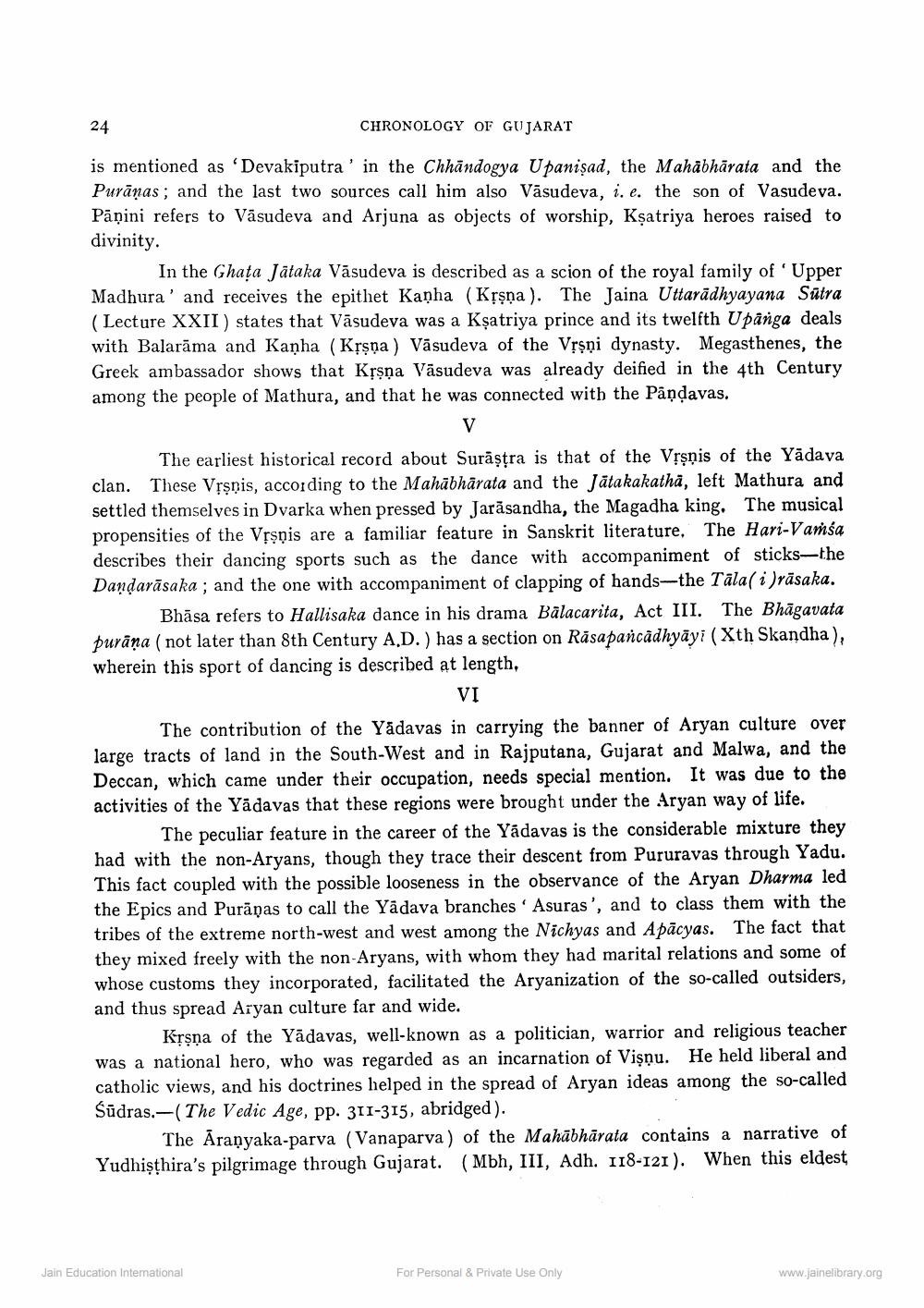________________
24
CHRONOLOGY OF GUJARAT
is mentioned as 'Devakiputra' in the Chhāndogya Upanişad, the Mahābhārata and the Purānas; and the last two sources call him also Vāsudeva, i.e. the son of Vasudeva. Pāṇini refers to Väsudeva and Arjuna as objects of worship, Kșatriya heroes raised to divinity.
In the Ghața Jātaka Vāsudeva is described as a scion of the royal family of Upper Madhura' and receives the epithet Kanha (Krşna). The Jaina Uttarādhyayana Sutra (Lecture XXII) states that Vasudeva was a Ksatriya prince and its twelfth Upanga deals with Balarāma and Kanha (Krsna) Vāsudeva of the Vrşņi dynasty. Megasthenes, the Greek ambassador shows that Krşņa Vāsudeva was already deified in the 4th Century among the people of Mathura, and that he was connected with the Pandavas.
V
The earliest historical record about Surāşțra is that of the Vrşņis of the Yādaya clan. These Vrsnis, according to the Mahābhārata and the Jātakakatha, left Mathura and settled themselves in Dvarka when pressed by Jarāsandha, the Magadha king. The musical propensities of the Vrsạis are a familiar feature in Sanskrit literature, The Hari-Vamsa describes their dancing sports such as the dance with accompaniment of sticks—the Dandarāsaka, and the one with accompaniment of clapping of hands-the Tāla( i )rāsaka.
Bhāsa refers to Hallisaka dance in his drama Bālacarita, Act III. The Bhagavata purāņa (not later than 8th Century A.D.) has a section on Rāsapancadhyāyi (Xth Skandha), wherein this sport of dancing is described at length,
VI The contribution of the Yādavas in carrying the banner of Aryan culture over large tracts of land in the South-West and in Rajputana, Gujarat and Malwa, and the Deccan, which came under their occupation, needs special mention. It was due to the activities of the Yādavas that these regions were brought under the Aryan way of life.
The peculiar feature in the career of the Yādavas is the considerable mixture they had with the non-Aryans, though they trace their descent from Pururavas through Yadu. This fact coupled with the possible looseness in the observance of the Aryan Dharma led the Epics and Purānas to call the Yādava branches' Asuras', and to class them with the tribes of the extreme north-west and west among the Nichyas and Apācyas. The fact that they mixed freely with the non-Aryans, with whom they had marital relations and some of whose customs they incorporated, facilitated the Aryanization of the so-called outsiders, and thus spread Aryan culture far and wide.
Krsna of the Yādavas, well-known as a politician, warrior and religious teacher was a national hero, who was regarded as an incarnation of Vişnu. He held liberal and catholic views, and his doctrines helped in the spread of Aryan ideas among the so-called Śūdras.-(The Vedic Age, pp. 311-315, abridged).
The Araṇyaka-parva (Vanaparva) of the Mahābhārata contains a narrative of Yudhisthira's pilgrimage through Gujarat. (Mbh, III, Adh. 118-121). When this eldest
Jain Education Interational
For Personal & Private Use Only
www.jainelibrary.org




